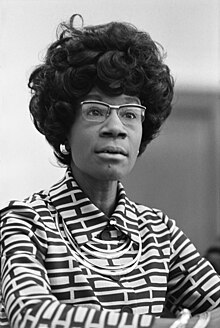Shirley Chisholm
| Shirley Chisholm | |
|---|---|

Chisholm in 1972
|
|
| Secretary of the House Democratic Caucus | |
|
In office January 3, 1977 – January 3, 1981 |
|
| Leader | Tip O'Neill |
| Preceded by | Patsy Mink |
| Succeeded by | Geraldine Ferraro |
| Member of the U.S. House of Representatives from New York's 12th district |
|
|
In office January 3, 1969 – January 3, 1983 |
|
| Preceded by | Edna Kelly |
| Succeeded by | Major Owens |
| Member of the New York State Assembly from the 55th district |
|
|
In office January 1, 1967 – December 31, 1968 |
|
| Preceded by | Herbert Marker |
| Succeeded by | Thomas Fortune |
| Member of the New York State Assembly from the 45th district |
|
|
In office January 1, 1966 – December 31, 1966 |
|
| Preceded by | Constituency established |
| Succeeded by | Max Turshen |
| Member of the New York State Assembly from the King's 17th district |
|
|
In office January 1, 1965 – December 31, 1965 |
|
| Preceded by | Thomas Jones |
| Succeeded by | Constituency abolished |
| Personal details | |
| Born |
Shirley Anita St. Hill November 30, 1924 New York City, New York, United States |
| Died | January 1, 2005 (aged 80) Ormond Beach, Florida, United States |
| Resting place | Forest Lawn Cemetery, Buffalo, New York |
| Political party | Democratic |
| Spouse(s) | Conrad Chisholm (1949–1977) Arthur Hardwick (1977–1986) |
| Alma mater |
Brooklyn College Teachers College, Columbia University |
| Religion | Baptist |
Shirley Anita St. Hill Chisholm (November 30, 1924 – January 1, 2005) was an American politician, educator, and author. In 1968, she became the first African American woman elected to the United States Congress, and she represented New York's 12th Congressional District for seven terms from 1969 to 1983. In 1972, she became the first black candidate for a major party's nomination for President of the United States, and the first woman to run for the Democratic Party's presidential nomination.
In 2015, Chisholm was posthumously awarded the Presidential Medal of Freedom.
Shirley Anita St. Hill was born on November 30, 1924, in Brooklyn, New York, to immigrant parents from the Caribbean region. She had three younger sisters, two born within three years after Shirley, one later. Their father, Charles Christopher St. Hill, was born in British Guiana, lived in Barbados for a while, and then arrived in the United States via Antilla, Cuba, on April 10, 1923, aboard the S.S. Munamar in New York City. Their mother, Ruby Seale, was born in Christ Church, Barbados, and arrived in New York City aboard the S.S. Pocone on March 8, 1921.
Her father was an unskilled laborer who sometimes worked in a factory that made burlap bags, but when he could not find factory employment instead worked as a baker's helper, while her mother was a skilled seamstress and domestic worker who had trouble working and raising the children at the same time. As a consequence, in November 1929 as Shirley turned five, she and her two sisters were sent to Barbados on the S.S. Vulcana to live with their maternal grandmother, Emaline Seale. There they lived on the grandmother's farm in the Vauxhall village in Christ Church, where she attended a one-room schoolhouse that took education seriously. She did not return to the United States until May 19, 1934, aboard the SS Nerissa in New York. As a result, Shirley spoke with a recognizable West Indian accent throughout her life. In her 1970 autobiography Unbought and Unbossed, she wrote: "Years later I would know what an important gift my parents had given me by seeing to it that I had my early education in the strict, traditional, British-style schools of Barbados. If I speak and write easily now, that early education is the main reason." As a result of her time on the island, and regardless of her U.S. birth, Shirley would always consider herself a Barbadian American. Regarding the role of her grandmother, she later said, "Granny gave me strength, dignity, and love. I learned from an early age that I was somebody. I didn't need the black revolution to tell me that."
...
Wikipedia
